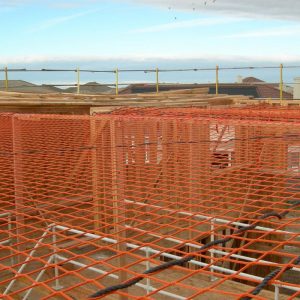Safety nets are designed to progressively deflect (stretch) and absorb the energy of a fall, so a falling person is less likely to be injured. The greater the fall height, the greater the impact; so the net’s deflection must also be greater.
2.1 Principles of safety net design
Safety nets are designed to progressively deflect (stretch) and absorb the energy of a fall, so a falling person is less likely to be injured. The greater the fall height, the greater the impact; so the net’s deflection must also be greater. The safety net must be able to deform or deflect enough to absorb all of the energy from the fall’s impact up to the maximum fall height for the design.
There must be enough clear distance below the net so that the person falling does not hit an obstacle or the ground while the net is deflecting.
2.2 Safety net systems
This guideline is for ‘System S’ safety nets, which are horizontally-installed safety nets with a continuous border rope.
Safety nets may be either knotted or knotless with a square (Q) or diamond (D) mesh arrangement.
Figure 1: Knotless, square mesh safety net.
Notes:
- When a load lands on a knotted net, the knots near the impact tighten. The tightening is permanent and reduces the amount of energy the net can absorb from further impacts. Knotless nets do not have this problem.
- A person who falls onto a knotless net is less likely to receive facial injuries.
- Square mesh is more popular than diamond mesh, with no obvious reason for the preference, according to research (1) in the UK.
- Square mesh has less sag when rigged so at its mid-point, it is closer to the work level.
WorkSafe recommends the use of knotless, square mesh for ‘S’ safety nets.
2.3 Safety net classification
BS EN 1263-1 lists four classes of nets:
- classes A and B describe the net’s maximum energy absorption capacity (that is, how much energy it can absorb), measured in kilojoules (kJ). For example: class A = 2.3 kJ; class B = 4.4 kJ
- classes 1 and 2 describe the mesh sizes. For example: class 1 = 60 mm; class 2 = 100 mm.

